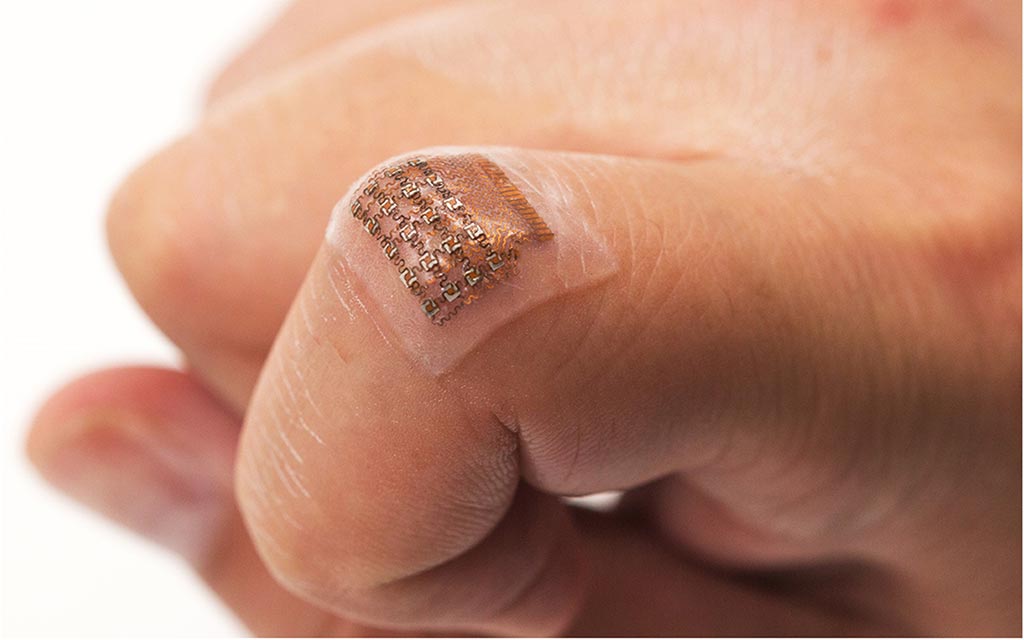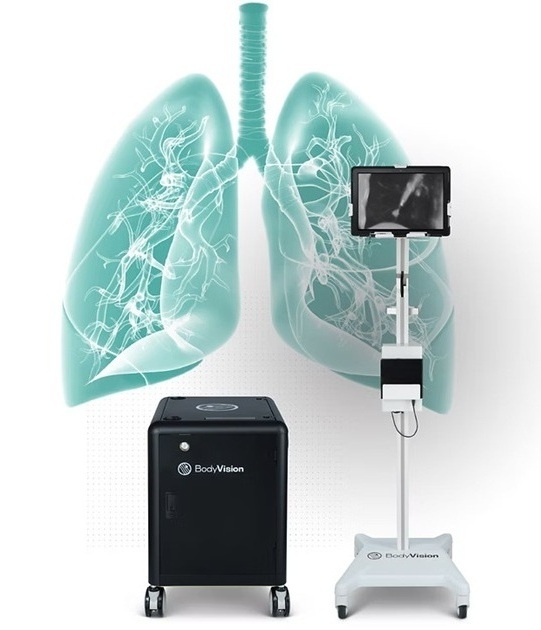Conformal Ultrasonic Patch Monitors Central Blood Pressure
|
By MedImaging International staff writers Posted on 24 Sep 2018 |

Image: A wearable ultrasound patch tracks blood pressure (Photo courtesy of Chonghe Wang/UCSD).
A new study describes how a wearable ultrasound patch that non-invasively monitors central blood pressure (BP) could detect cardiovascular problems earlier on.
Developed at the University of California, San Diego (UCSD, USA), the ultrasonic device is made of a thin sheet of silicone elastomer embedded with an array of small piezoelectric transducers connected by thin, spring-like copper bridging wires. The result is an ultrathin (240 μm) and stretchable patch that conforms to the skin, enabling non-invasive, continuous capture of BP waveforms by sending ultrasound waves that record the diameter of arterial and venous sites blood vessels located as deep as four centimeters below the skin, even through fatty tissues.
The changing diameter of the deeply embedded vessel, which is modified by the pulsations of the blood plowing through it, is recorded by the piezoelectric transducers and translated into a visible waveform using customized software. Each peak, valley and notch in the waveform, as well as the overall shape, represents a specific activity or event in the heart, providing detailed information to doctors assessing a patient's cardiovascular health. The study was published on September 11, 2018, in Nature Biomedical Engineering.
“Wearable devices have so far been limited to sensing signals either on the surface of the skin or right beneath it; but that is like seeing just the tip of the iceberg. We are adding a third dimension to the sensing range of wearable electronics,” said senior author professor of nanoengineering Sheng Xu, PhD, of the UCSD Jacobs School of Engineering. “By integrating ultrasound technology into wearables, we can start to capture a whole lot of other signals, biological events, and activities going on way below the surface in a non-invasive manner.”
“Non-invasive approaches, including photoplethysmography and tonometry, only enable access to the superficial peripheral vasculature. Although current ultrasonic technologies allow non-invasive deep tissue observation, unstable coupling with the tissue surface resulting from the bulkiness and rigidity of conventional ultrasound probes introduces usability constraints,” concluded lead author graduate student Chonghe Wang, MSc, and colleagues. “Continuous monitoring of the central blood pressure waveform from deeply embedded vessels such as the carotid artery and jugular vein has clinical value for the prediction of all-cause cardiovascular mortality.”
Related Links:
University of California, San Diego
Developed at the University of California, San Diego (UCSD, USA), the ultrasonic device is made of a thin sheet of silicone elastomer embedded with an array of small piezoelectric transducers connected by thin, spring-like copper bridging wires. The result is an ultrathin (240 μm) and stretchable patch that conforms to the skin, enabling non-invasive, continuous capture of BP waveforms by sending ultrasound waves that record the diameter of arterial and venous sites blood vessels located as deep as four centimeters below the skin, even through fatty tissues.
The changing diameter of the deeply embedded vessel, which is modified by the pulsations of the blood plowing through it, is recorded by the piezoelectric transducers and translated into a visible waveform using customized software. Each peak, valley and notch in the waveform, as well as the overall shape, represents a specific activity or event in the heart, providing detailed information to doctors assessing a patient's cardiovascular health. The study was published on September 11, 2018, in Nature Biomedical Engineering.
“Wearable devices have so far been limited to sensing signals either on the surface of the skin or right beneath it; but that is like seeing just the tip of the iceberg. We are adding a third dimension to the sensing range of wearable electronics,” said senior author professor of nanoengineering Sheng Xu, PhD, of the UCSD Jacobs School of Engineering. “By integrating ultrasound technology into wearables, we can start to capture a whole lot of other signals, biological events, and activities going on way below the surface in a non-invasive manner.”
“Non-invasive approaches, including photoplethysmography and tonometry, only enable access to the superficial peripheral vasculature. Although current ultrasonic technologies allow non-invasive deep tissue observation, unstable coupling with the tissue surface resulting from the bulkiness and rigidity of conventional ultrasound probes introduces usability constraints,” concluded lead author graduate student Chonghe Wang, MSc, and colleagues. “Continuous monitoring of the central blood pressure waveform from deeply embedded vessels such as the carotid artery and jugular vein has clinical value for the prediction of all-cause cardiovascular mortality.”
Related Links:
University of California, San Diego
Latest Ultrasound News
- New Incision-Free Technique Halts Growth of Debilitating Brain Lesions
- AI-Powered Lung Ultrasound Outperforms Human Experts in Tuberculosis Diagnosis
- AI Identifies Heart Valve Disease from Common Imaging Test
- Novel Imaging Method Enables Early Diagnosis and Treatment Monitoring of Type 2 Diabetes
- Ultrasound-Based Microscopy Technique to Help Diagnose Small Vessel Diseases
- Smart Ultrasound-Activated Immune Cells Destroy Cancer Cells for Extended Periods
- Tiny Magnetic Robot Takes 3D Scans from Deep Within Body
- High Resolution Ultrasound Speeds Up Prostate Cancer Diagnosis
- World's First Wireless, Handheld, Whole-Body Ultrasound with Single PZT Transducer Makes Imaging More Accessible
- Artificial Intelligence Detects Undiagnosed Liver Disease from Echocardiograms
- Ultrasound Imaging Non-Invasively Tracks Tumor Response to Radiation and Immunotherapy
- AI Improves Detection of Congenital Heart Defects on Routine Prenatal Ultrasounds
- AI Diagnoses Lung Diseases from Ultrasound Videos with 96.57% Accuracy
- New Contrast Agent for Ultrasound Imaging Ensures Affordable and Safer Medical Diagnostics
- Ultrasound-Directed Microbubbles Boost Immune Response Against Tumors
- POC Ultrasound Enhances Early Pregnancy Care and Cuts Emergency Visits
Channels
Radiography
view channel
Machine Learning Algorithm Identifies Cardiovascular Risk from Routine Bone Density Scans
A new study published in the Journal of Bone and Mineral Research reveals that an automated machine learning program can predict the risk of cardiovascular events and falls or fractures by analyzing bone... Read more
AI Improves Early Detection of Interval Breast Cancers
Interval breast cancers, which occur between routine screenings, are easier to treat when detected earlier. Early detection can reduce the need for aggressive treatments and improve the chances of better outcomes.... Read more
World's Largest Class Single Crystal Diamond Radiation Detector Opens New Possibilities for Diagnostic Imaging
Diamonds possess ideal physical properties for radiation detection, such as exceptional thermal and chemical stability along with a quick response time. Made of carbon with an atomic number of six, diamonds... Read moreMRI
view channel
New MRI Technique Reveals Hidden Heart Issues
Traditional exercise stress tests conducted within an MRI machine require patients to lie flat, a position that artificially improves heart function by increasing stroke volume due to gravity-driven blood... Read more
Shorter MRI Exam Effectively Detects Cancer in Dense Breasts
Women with extremely dense breasts face a higher risk of missed breast cancer diagnoses, as dense glandular and fibrous tissue can obscure tumors on mammograms. While breast MRI is recommended for supplemental... Read moreNuclear Medicine
view channel
New Imaging Approach Could Reduce Need for Biopsies to Monitor Prostate Cancer
Prostate cancer is the second leading cause of cancer-related death among men in the United States. However, the majority of older men diagnosed with prostate cancer have slow-growing, low-risk forms of... Read more
Novel Radiolabeled Antibody Improves Diagnosis and Treatment of Solid Tumors
Interleukin-13 receptor α-2 (IL13Rα2) is a cell surface receptor commonly found in solid tumors such as glioblastoma, melanoma, and breast cancer. It is minimally expressed in normal tissues, making it... Read moreGeneral/Advanced Imaging
view channel
First-Of-Its-Kind Wearable Device Offers Revolutionary Alternative to CT Scans
Currently, patients with conditions such as heart failure, pneumonia, or respiratory distress often require multiple imaging procedures that are intermittent, disruptive, and involve high levels of radiation.... Read more
AI-Based CT Scan Analysis Predicts Early-Stage Kidney Damage Due to Cancer Treatments
Radioligand therapy, a form of targeted nuclear medicine, has recently gained attention for its potential in treating specific types of tumors. However, one of the potential side effects of this therapy... Read moreImaging IT
view channel
New Google Cloud Medical Imaging Suite Makes Imaging Healthcare Data More Accessible
Medical imaging is a critical tool used to diagnose patients, and there are billions of medical images scanned globally each year. Imaging data accounts for about 90% of all healthcare data1 and, until... Read more
Global AI in Medical Diagnostics Market to Be Driven by Demand for Image Recognition in Radiology
The global artificial intelligence (AI) in medical diagnostics market is expanding with early disease detection being one of its key applications and image recognition becoming a compelling consumer proposition... Read moreIndustry News
view channel
GE HealthCare and NVIDIA Collaboration to Reimagine Diagnostic Imaging
GE HealthCare (Chicago, IL, USA) has entered into a collaboration with NVIDIA (Santa Clara, CA, USA), expanding the existing relationship between the two companies to focus on pioneering innovation in... Read more
Patient-Specific 3D-Printed Phantoms Transform CT Imaging
New research has highlighted how anatomically precise, patient-specific 3D-printed phantoms are proving to be scalable, cost-effective, and efficient tools in the development of new CT scan algorithms... Read more
Siemens and Sectra Collaborate on Enhancing Radiology Workflows
Siemens Healthineers (Forchheim, Germany) and Sectra (Linköping, Sweden) have entered into a collaboration aimed at enhancing radiologists' diagnostic capabilities and, in turn, improving patient care... Read more




















